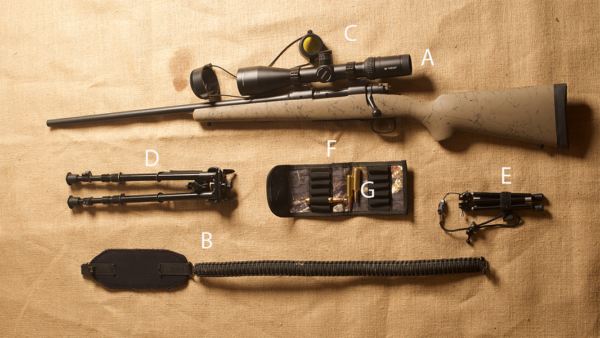
Hunters take the subject of rifles so seriously that arguments about calibers can literally end friendships. People are willing to go to blows in defense of their favorite gun’s reputation, and I suppose it’s for good reason. Your rifle is one of your most important pieces of big game hunting gear. If you lack faith in your rifle’s ability to shoot straight and true, it becomes hard to perform all the necessary work that goes into a successful hunt. While there are many styles of rifles on the market, including a rapidly increasing array of AR-format weapons, the tried-and-true bolt-action rifle is still the standard go-to weapon for serious big game hunters.
“Don’t be intimidated by anyone’s experience, including mine. There have been and still are a few good writers with vast experience in the firearms field. There are also plenty of plain old fools writing about guns and shooting and plenty of younger fools, as well. Gun writers, especially those who have to produce a regular column, love controversy. That column becomes a beast that must be fed every month, so the columnist is always hungry for something to write about and controversial ideas generate reader interest and response. Perhaps it is understandable if they sometimes go overboard. Just don’t go overboard with them.” –Chuck Hawks
Properly tuned and outfitted, and with a disciplined and well-practiced shooter, a high-caliber bolt-action rifle topped with a variable-power scope can meet 95% of the big game hunting challenges that this continent has to offer. For maximum versatility and ease of finding ammunition, stick to common, time-proven big-game calibers such as .270, 7mm Rem Mag, 30-06, .308 Winchester, and 300 Win Mag, plus the short magnum versions of these same calibers.
These might seem a tad heavy for a North Carolina whitetail deer hunter, and some might be a tad light for an Alaska hunter who’s itching to tangle with a coastal brown bear. But they are all superb guns for a generalist hunter who wants to be ready for anything without having to burn up his paychecks on an arsenal of weapons. After all, the North Carolina hunter might eventually run into one of that state’s 500-pound black bears, and the Alaska hunter might get tired of trimming around fist-sized exit holes blown through his game meat by a mule-kicking elephant gun.

Additional components
B: Handmade sling with neoprene shoulder pad and braided paracord strap. An average hunting rifle weighs approximately 9 pounds. Carrying that amount of weight all day can be annoying and exhausting. Do not skimp on slings. The cheap ones fall apart. This type of sling gives you emergency access to over a hundred feet of 550-pound test cord.
C: Vortex Scope Cover. An essential but often overlooked piece of gear. Scopes are expensive and you don’t want the lens to get scratched. Plus, it’s difficult or even impossible to aim when your lenses are obscured by snow or excessive moisture. Neoprene “scope socks” are a another good bet because they’re inexpensive, long-lasting, and provide a bit of protection against impacts to the scope body. Rubber “bikini-style” scope covers are great at keeping out moisture but they tend to fall apart. Same with flip-cap scope covers. If you’re sitting in a blind, these are fine, but hardcore backpack hunters often find that flip-caps are easy to demolish.
D: Heavy-duty Harris Bipod. Perfect for long-range shooting from a prone position, but hardly essential in areas where long-range shots are not likely. This type of bipod can folded forward so it’s out of the way when not in use. The downside is that they are a tad heavy and tend to get hung up when hiking through thick brush.
E: Snipe-pod bipod. A lightweight detachable bipod that can be worn on your belt and quickly attached to the rifle before shooting. Downside is that it’s not as stable as the Harris bipod.
F: Folding ammo wallet. Keeps ammo organized and prevents annoying rattle of loose cartridges in your pack or pocket.
G: .270 WSM cartridges loaded with Barnes 129-grain LRX bullet.
Not shown
Muzzle Cover: A rifle muzzle that is plugged with mud or snow is very dangerous, as the barrel could potentially rupture when you fire it. Cover your muzzle to prevent the intrusion of mud, snow, dust, or moisture into your barrel by using a piece or tape or, better, a heavy-duty small-size latex finger cot. Using a muzzle cover has been proven not to affect point of impact, as the gasses moving ahead of the bullet blow off whatever cover is on your muzzle.
Gun Sock: This model is the Solo Hunter Gun Cover. Keeps your firearm protected from snow and mud while in the field and still allows for immediate access.
Travel Case: A good travel case protects from dings and scratches incurred from travel. Besides cosmetics, this ensures that your scope doesn’t get knocked out of zero. Hard sided cases, such as those from Pelican or Boyt, come with a protective foam insert that can be cut to accommodate your specific firearm. Airlines require such hard-sided cases and mandate that the case be locked.

As pictured left to right,
The light side: .243 Winchester, .25-06 Remington
The middle ground: .270 Winchester, .308 Winchester, 30-06 Springfield, 7mm Remington Magnum, and 300 Winchester Magnum
The heavy side: .338 Winchester Magnum, .338 Remington Ultra magnum, .375 Holland & Holland magnum




